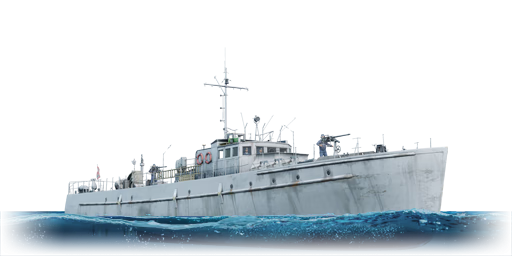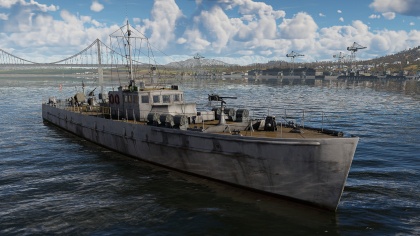R-41
Contents
Description
The R-41-class, R-41 is a rank I German motor gun boat
with a battle rating of 1.0 (AB/RB/SB). It was introduced in Update 1.79 "Project X" as part of the fleet closed beta test.
General info
Survivability and armour
The R-41 is constructed using mostly wood, the superstructure and hull are wooden. The wooden construction of the R-41 means fire is one of the biggest threats to the survival of this ship, the hull will not absorb so much damage. There is no armour on the ship. The R-41 has a crew placement of 34, which provides a great attachment of sailors, which helps to increases the overall survivability of the R-41 dramatically compared to other ships in this tier.
However, the internal components of the R-41 are spaced out, meaning a good volley of enemy fire will not completely incapacitate the ship.
- The engine is placed, under the conning tower of the ship, with the transmission extending towards the stern (rear) to the Voith Schneider propulsion system.
- The transmission is under the waterline which protects it from most enemy rounds, which would penetrate the ship.
- Enemy fire can destroy the Voith Schneider propulsion system as it extends above the waterline.
- Enemy fire can penetrate the ship's fuel and ammunition storage due to the fact that these locations are above the waterline.
Mobility
The R-41 is slow in comparison to other boats at this tier, however, it is equipped with a Voith Schneider propulsion system, which makes up for the slow top speed. The Voith Schneider propulsion system empowers the R-41 (and R-boot R-130) with a top speed of 50 KM/H in arcade battles. In realistic and simulator modes, it has a top speed of 37 KM/H, which is still respectfully fast, for a naval ship.
Unlike other ships which use a conventional propeller & rudder system, the Voith-Schneider Propulsion (VSP) system uses a "cyclorotor" which provides incredible manoeuvrability, allowing incoming enemy fire and torpedoes to be dodged, just before they are about to impact the ship, without delay, whilst keeping the top speed almost the same. This effect is only partially modelled as of update 1.99.
Armament
Primary armament
The two cm/65 C/30 (20 mm) automatic cannons are equipped with a 40 round magazine. To best utilise the cannon in a naval battle environment, ideally use universal or the APT magazine choice. These provide the most stopping power in a ship to ship encounter. When operating the cannons, aim in front of the enemy ship, and adjust the fire by watching the tracer rounds hit the target. Locate the key areas which are important for the rivalship to survive and target those i.e. Bridge, Engine room, Ammunition storage areas.
The cm/65 C/30 (20 mm) automatic cannons work very well in close and medium-range engagement. However, at a long-distance engagement, they are not as effective as other types of guns or cannons.
When engaging enemy aircraft, the cm/65 C/30 (20 mm) automatic cannons are able to deliver a catastrophic blow to any enemy aircraft, which may decide your attack. The hitting power from these rounds, make this one of the most powerful anti-air deterrence in the game. With a few well-placed shots, Aim for the wing spars and engines the enemy aircraft will soon be destroyed.
The magazine (ammo) choices are:
- Universal
- HET
- APT
These require a 4 to 5.2 second reload time to replace a used magazine with a new one. To get the stupendous 4 seconds reload time, the crew requires an ace qualification, with crew skills to be fully achieved in the main calibre reload speed field.
Special armament
The WBF depth charge, holds 60 kg of an explosive charge, it is a great weapon in the hands of a skilled captain, the depth charge can be placed to cause destruction to enemy ships by exploding below. The only reason the depth charge should be used on these types of ships is if enemy ships get to close. Depth charges are more inline to be a defensive weapon, instead of an offensive weapon. This ship uses the Voith Schneider propulsion system which provides incredible manoeuvrability, it is very easy to manoeuvre the bow where these are placed and drop them all under the enemy ship, causing the rival to explode.
It is important to remember that if they are destroyed on deck, it could also destroy the ship.
Usage in battles
The R-boot R-41 is long, lacks any armour but is highly manoeuvrable with it's Voith Schneider propulsion system. This empowers sharp and fast turns which allow the ship to make sudden broadsides with its great armament which is able to accurately knock out an enemy target with a good range. The propulsion system, allows enemy shells to be dodged and courses changed, putting enemy range finders to shame.
This boat could be compared to a lobster, you will not be the first to cap a zone, but you will get there. You will be able to defend off attackers, whether it be air or naval units.
It is important to turn the ship into them, keeping the profile small, until you are within range to turn the ship broadside to bear the powerful cannons on to the opposing ship. If it is possible to get as close as you can, then drop some depth charges under them to knock them out with a splash!
The 20mm autocannons, when using the cannons, make sure to track each round and adjust them - as soon as the rounds start hitting they will be dealing damage to the enemy ship or aircraft.
The most dangerous foes which this ship could face is are small fast attack and cannon equipped ships such as the G-5, which small profile and incredible manoeuvrability allow it to get close, it packs a powerful 12.7mm machine gun or for the G-5 (ShVAK) which features a 20mm cannon!
The BMO, Pr.1124 and others like this, offer a sleek stealthy silhouette which can be hard to detect and could be easily missed in the heat of battle. Which can also be hard to knock out since they are armoured very well with armour plating. These ships also offer firepower which can knock out some of the biggest and meanest ships, with some well-placed shots, Flower class, PC-451 are also to be watched out for.
These ships can be countered by knocking out the main armament, first with well-placed shots. Once this is done, aim for the centre of the ship, and bridge area were the majority of the crew is located and fire up down its length, until it is knocked out.
Modules
| Tier | Seakeeping | Unsinkability | Firepower | |||
|---|---|---|---|---|---|---|
| I | Dry-Docking | Tool Set | 20 mm HET magazines | |||
| II | Rudder Replacement | Fire Protection System | Smokescreen | 20 mm APT magazines | ||
| III | Propeller Replacement | Primary Armament Targeting | Depth Charges | |||
| IV | Engine Maintenance | New Pumps | Artillery Support | |||
Pros and cons
Pros:
- Powerful & accurate weaponry
- Excellent handing
- Good top speed in both AB, RB and SB Modes
- Spaced out crew, increased the survivability in battle
Cons:
- Only has two cannons installed
- Only 40 rounds of ammo per magazine
- Requires up to 5.2 seconds to reload a magazine
- No hardened armour or armour plates installed on the ship
History
Developed in the inter-war period, the R-Boots (Raumbootes) were designed as minesweepers, and they had deliberately low draughts in order to operate close to the coast. The armament was limited due to the intended mission of the ships. Propulsion was provided by two MAN marine diesel engines, providing 1,836 horsepower each and driving two shafts. Construction utilized a metal understructure and wooden framing.
424 R-Boots were completed, and they continually saw service up until 1945. They were notably used during the 1940 invasion of Norway. Only 140 of these ships survived the war, with many captured by the Allies or divided up between the Allies as spoils of war. 24 R-Boots were eventually reintroduced to the West German Navy and operated until the 1960’s.
The R-Boots, despite being built as minesweepers, were forced into other roles during the war. They were used for search-and-rescue (SAR), ship hunting, coastal patrol, and convoy escort, among other duties such as minelaying. The ships were rarely used in their intended role (minesweeping) because of the defensive nature of the war for the Kriegsmarine.
R-41 was the lead ship of an R-Boot class, significantly larger than the preceding R-25. It had a length of 37.8 meters and a displacement of 125 tons. This class consisted of R-41 through R-129, and the class was constructed until 1943.
Media
Excellent additions to the article would be video guides, screenshots from the game, and photos.
See also
Links to articles on the War Thunder Wiki that you think will be useful for the reader, for example:
- reference to the series of the ship;
- links to approximate analogues of other nations and research trees.
External links
Paste links to sources and external resources, such as:
- topic on the official game forum;
- encyclopedia page on the ship;
- other literature.
| Germany boats | |
|---|---|
| Motor torpedo boats | LS 3 · LS 4 Esau · KM-5 · VS-10 |
| S-38 · S-38b · S-100 · S-147 · S-204 Lang · S-701 | |
| R-301 | |
| V-990 | |
| Jaguar · Hugin · Pfeil | |
| Motor gun boats | R-41 · R-130 · Krischan der Große |
| Motor torpedo gun boats | Albatros · Bussard · MZ1 · Pr. 206 |
| Minelayers | VS-8 |





